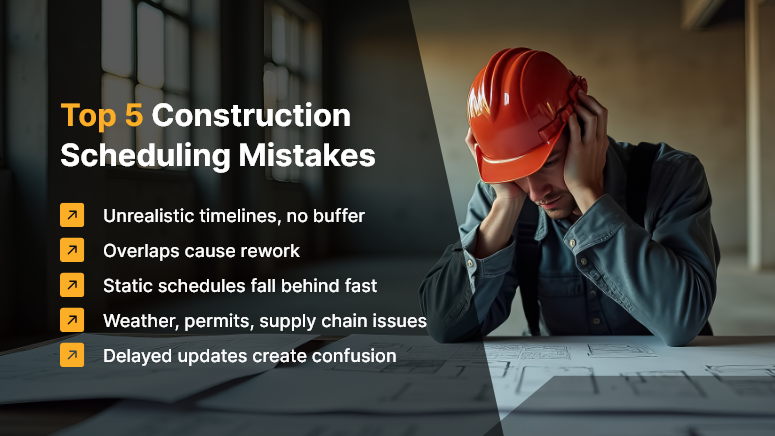Ever been on a job site where the crew shows up ready to work, but the materials aren’t there yet? Everyone just stands around, burning time — and money.
Or maybe you’ve had that sinking feeling when a client calls asking, “Why is the project behind schedule?” and you don’t have a solid answer.
If you’ve been in construction long enough, you’ve probably lived through both. The truth is, even the best teams fall victim to scheduling mistakes. And when they do, the ripple effect is brutal — missed milestones, higher costs, frustrated crews, and unhappy clients.
According to McKinsey, big construction projects take 20% longer than planned. And yes, scheduling problems are a huge reason why.
But here’s the thing: it doesn’t have to be this way. Most scheduling mistakes are avoidable. And with the right tools (hello, OConstruction), you can keep your projects moving like clockwork.
Let’s walk through the five most common scheduling mistakes — the ones I’ve seen over and over — and more importantly, how to avoid them.

Why Scheduling Mistakes Hurt More Than You Think
Your schedule isn’t just a timeline. It’s the backbone of your entire project.
Think about it: every crew, every supplier, every permit — they all depend on it. When the schedule slips, everything else starts to wobble.
- Crews show up before materials.
- Deadlines overlap, causing rework.
- Clients get vague updates and lose trust.
And suddenly, you’re not just managing a project. You’re putting out fires.
Now flip the script. When your scheduling is solid, you’re in control:
- Costs stay under control.
- Resources are used efficiently.
- Clients actually trust your process.
That’s the power of getting it right.
Mistake #1: Underestimating Task Durations
We’ve all been there. A task looks simple on paper, so you assign a quick turnaround. Then reality kicks in — site conditions, unexpected complexity, permit delays — and suddenly that “three-day task” stretches into two weeks.
The fix: Stop guessing. Use real data. OConstruction lets you pull from historical projects so your estimates aren’t just optimistic guesses. And don’t forget to add a little buffer for the unexpected. Because in construction, the unexpected is the rule, not the exception.
Mistake #2: Ignoring Task Dependencies
Picture this: the drywall crew is ready, but the electrical work isn’t finished. Now you’ve got wasted labor and a frustrated crew.
The fix: Map it out visually. With OConstruction’s Gantt charts, you can see dependencies at a glance. The system even flags conflicts before they blow up your timeline.
Mistake #3: Treating the Schedule as Static
Too many teams build a beautiful schedule at the start — then never touch it again. Weeks later, reality and the schedule don’t match, and no one knows what’s really happening.
The fix: Treat your schedule like a living, breathing thing. Update it often. With OConstruction, progress updates are live. Missed milestones, shifting timelines, new changes — everyone sees it in real time.
Mistake #4: Forgetting About Risks
Weather delays. Supply shortages. Permits are stuck in approval. These things aren’t “what ifs.” They’re when, not if.
The fix: Plan for them. Build contingency time into your schedule. With OConstruction, you can tag and track risks so you’re not blindsided when they hit. Instead of scrambling, you’re ready.
Mistake #5: Poor Communication
This one stings the most. Imagine your client only finds out about a delay after they show up on site. Or crews get conflicting instructions about when to start. Miscommunication doesn’t just cause delays — it damages trust.
The fix: Overcommunicate. Automate updates. OConstruction makes it simple with built-in notifications and status reports. Everyone — clients, crews, suppliers — stays in the loop.
A Real-World Example
Take SummitWorks Construction. They were constantly rescheduling because suppliers delivered late. Crews would arrive ready to work, but the materials weren’t there. Morale dropped. Clients were frustrated. Costs went up.
Then they switched to OConstruction.
- Supplier delivery schedules got synced directly into their project plans.
- Automated alerts went out the moment something changed.
- Crews stayed informed and ready.
The result? 28% fewer overruns in just six months. Costs dropped, clients were happier, and repeat business shot up.
That’s the difference between firefighting and smooth sailing.
Key Takeaways
Avoiding scheduling mistakes isn’t about working harder — it’s about being smarter. Here’s what successful construction teams do differently:
1. Be Realistic – Use Data, Not Guesswork
Overly ambitious timelines might look good in the bid, but they rarely survive on the ground. Smart project managers use historical data and lessons learned from past jobs to set achievable timelines. OConstruction makes this easier by storing project records you can reference when planning. That way, your schedules aren’t based on optimism — they’re based on reality.
2. Stay Proactive – Keep the Schedule Alive
A construction schedule isn’t a one-and-done document. It’s a living plan that shifts as the project progresses. Too many teams forget to update it, which confuses, missed milestones, and chaos on site. With OConstruction’s real-time updates, your schedule adjusts dynamically so everyone knows exactly where the project stands — today, not last month.
3. Plan for Risks Before They Happen
Rain, late permits, supply chain hiccups — they’re not “if,” they’re “when.” Ignoring them is like walking onto a site without safety gear. By building in risk buffers and contingency plans, you create breathing room for your project. OConstruction lets you tag potential risks, track their impact, and respond quickly when something goes wrong. It’s about expecting the unexpected.
4. Keep Everyone Connected – No Surprises
Nothing frustrates clients and crews more than being left in the dark. A missed update can erode trust faster than a missed milestone. By automating updates and sharing schedule changes instantly, you make sure stakeholders always know what’s happening. With OConstruction, clients feel informed, crews know when to show up, and suppliers stay aligned — no more last-minute surprises.
The Bottom Line
When you get scheduling right, projects run smoother, crews stay productive, costs stay under control, and clients actually enjoy working with you. It’s not just about finishing on time — it’s about building a reputation for reliability. And that’s exactly what OConstruction helps you achieve.





